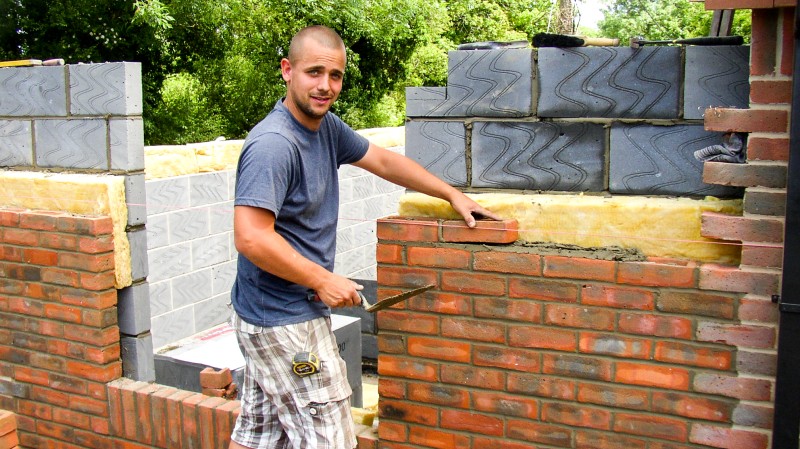You are here: Rise of self-build communities
Making it easier and less risky to build your own home
Many people dream of building their own Grand Designs home but the reality is difficulty finding a plot, battles over planning and lack of finance. At Graven Hill in Oxfordshire, the innovative district council bought hundreds of acres of former Ministry of Defence land, then carved out 2,000 plots, the street layout and a design code for the housing. People pick their own plot - ranging in size from a two-bed flat through to a six-bed detached house - and planning is fast-tracked in just 28 days. Graven Hill is the biggest and best-known self-build site, but others are popping up across the country.

What is self-build housing?
When people think of self-building, they usually imagine future homeowners laying the bricks and mortar themselves. Or a couple in hard hats having tricky conversations with their architect about spiralling costs. The UK Government prefers to use the term “self-build and custom-build.” This includes self-builders who want to be hands-on but also the majority who hire architects and building contractors to design and build the home of their dreams. Custom build even extends to those who simply select from standardised home layouts supplied by a specialist company. Self-builders can be individuals or groups.
Why isn’t there more self-build?
Self-build has never really taken off in this country like it has in other parts of Europe. Currently only about 10% of UK homes are self-build compared to 80% in Austria and 60% in Germany. The biggest obstacles to self-build are lack of available plots and the high level of planning regulation, according to the National Custom and Self Build Association (NCSBA), which lobbies government for change. It’s no coincidence the UK has a strong mass house building sector which can afford to take options on undeveloped land and push for it to be reclassified for building in five, 10 or 15 years. Individual self-builders can’t compete with housing giants.
In a bid to boost supply, right to build legislation was introduced in 2016 in England, though not in Scotland, Wales or Northern Ireland. This means if you live in England your local planning authority must keep a register of people looking to build their own homes. Councils also have a duty to make sure enough serviced plots come on the market to meet demand when drawing up local plans, approving applications and negotiating with developers. Some take their duties more seriously than others.
Each person or group accepted on the register is notified when a site becomes available for purchase. However, councils don’t have to provide you with the size of plot you want or in the area you prefer, so it could be a long and fruitless wait. For example, the only properties currently listed on Winchester City Council’s website (May 20, 2022) are a first-floor office space and a ground floor unit in a parade of shops - both rentals. Not a single plot suitable for self-builders was listed.
That said, it’s still worth signing up to your local council’s register as well as other areas where you might consider living. This will put pressure on councils to bring forward plots for custom and self-build. Individual plots for sale are also listed on popular property portals, such as Rightmove and Zoopla. Other useful websites include www.plotfinder.net/home and www.selfbuildportal.org.uk
Self-build and custom-build schemes
Self-build and custom-build schemes involve buying a plot on a larger site – so the search for land, obtaining planning permission and getting the services installed is all done for you. It’s easier and less risky. From this point, there are several different routes you can go down to achieve your dream home from hiring your own architect and builder to using a specialist design and build company. The key point is you have more choice; you don’t have to accept a standard Barratt or Taylor Wimpey home, for example.
Specialist company Potton offers self-build plots at sites across the UK, including Hampshire, Cambridgeshire, Kent, Swindon, Bicester and Tunbridge Wells. Many of the plots are already reserved, showing it is a popular option.
More local councils are now exploring how to support self and custom build. Cherwell District Council at Graven Hill has blazed a trail while most are still at the drawing board stage.
Planning and design codes
At Graven Hill there is a prescribed palette of materials to give a more Oxfordshire feel to the project, so there aren’t many wild and wacky designs. Councils are increasingly using design codes for developments of more than 10 homes that allow fast-tracking of individual applications. According to the Right to Build Taskforce, a government-funded professional advice service, a good design code will still allow for “creativity, innovation and originality while specifying what is mandatory and what is optional.” The code should be design neutral if possible, allowing for contemporary or traditional architecture and advanced methods of construction, sayz the taskforce.
Community self-build
Across the UK, there are niche community self-builds often aimed towards a shared lifestyle. For example, the not-for-profit Lancaster Co-housing Group, set up in 2006 on the outskirts of Preston, has an emphasis on communal living with shared meals and joint decision-making.
In Leeds, the Low Impact Living Affordable Community (Lilac), has proved cheaper than conventional new homes. It began with a group of five Leeds residents interested in building their own homes who set up the UK’s first Mutual Home Ownership Society, a model popular in Scandinavia. With help from the city council and other bodies, they raised the capital and hired an architect and builder. The co-housing community of 20 eco-build homes was completed in 2013 when the first residents moved in.
Is self-build and custom-build the future?
There is now Government funding for councils to make their surplus brownfield land available for self-build and custom building. Plus, a Help to Build fund, confirmed in April 2021; pot of £150m over four years to make low-deposit mortgages available for self and custom-build homes which should help some people.
Pioneering Graven Hill shows what is possible on a mass scale. It could be copied by councils across the UK, or government could step in and make more land available to self-builders. Of course, surplus public land is a limited resource and will eventually run out. A radical new approach is needed for self-building to become something that millions of people can do rather than just watch on TV.
Useful sources: The National Custom and Self Build Association; Buildstore; SelfBuild Central and the Self Build Portal.
If you are looking to make some home improvements, you may find some of these services useful
Building Regulations
Find details of local experts who can help with Building Regulations
Builders
Find local help with a building project
Architectural Design Services
Find local Architectural Design experts
Structural Inspections
Find an expert to carry out a structural inspection
Building Surveys
I want a local surveyor to do a Building Survey for me
Choose which Architectural service you require
If you are not sure which service you require, check out the options available...


